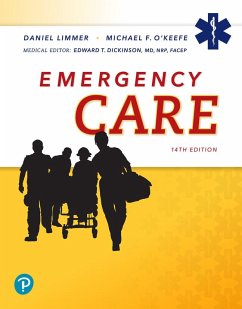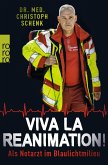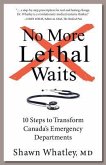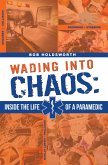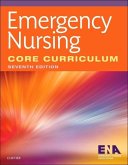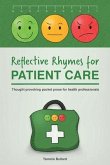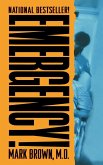Andere Kunden interessierten sich auch für
![Viva La Reanimation! Viva La Reanimation!]() Christoph SchenkViva La Reanimation!13,00 €
Christoph SchenkViva La Reanimation!13,00 €![Einsatztaktik Einsatztaktik]() Achim HacksteinEinsatztaktik10,90 €
Achim HacksteinEinsatztaktik10,90 €![No More Lethal Waits: 10 Steps to Transform Canada's Emergency Departments No More Lethal Waits: 10 Steps to Transform Canada's Emergency Departments]() Shawn WhatleyNo More Lethal Waits: 10 Steps to Transform Canada's Emergency Departments17,99 €
Shawn WhatleyNo More Lethal Waits: 10 Steps to Transform Canada's Emergency Departments17,99 €![Wading Into Chaos Wading Into Chaos]() Bob HoldsworthWading Into Chaos17,99 €
Bob HoldsworthWading Into Chaos17,99 €![Emergency Nursing Core Curriculum Emergency Nursing Core Curriculum]() Emergency Nurses AssociationEmergency Nursing Core Curriculum123,99 €
Emergency Nurses AssociationEmergency Nursing Core Curriculum123,99 €![Reflective Rhymes for Patient Care Reflective Rhymes for Patient Care]() Tammie BullardReflective Rhymes for Patient Care15,99 €
Tammie BullardReflective Rhymes for Patient Care15,99 €![Emergency! Emergency!]() Mark BrownEmergency!22,99 €
Mark BrownEmergency!22,99 €-
-
-
Produktdetails
- Verlag: Pearson
- 14. Auflage
- Seitenzahl: 1456
- Erscheinungstermin: März 2025
- Englisch
- Abmessung: 275mm x 215mm x 50mm
- Gewicht: 2871g
- ISBN-13: 9780136681168
- ISBN-10: 0136681166
- Artikelnr.: 70117157
Hinweis: Dieser Artikel kann nur an eine deutsche Lieferadresse ausgeliefert werden.
- Herstellerkennzeichnung
- Pearson
- St.-Martin-Straße 82
- 81541 München
- salesde@pearson.com
- +4989541960460
Daniel Limmer began working in EMS in 1978. He became an EMT in 1980 and a paramedic in 1981. Currently, he is a lecturer at Central Washington University in Ellensburg, Washington, and an adjunct faculty member at Eastern Maine Community College in Bangor, Maine. He especially enjoys teaching patient assessment and believes critical thinking and decision-making skills are the key to successful clinical practice of EMS. In addition to his EMS experience, was a dispatcher and police officer in upstate New York. Daniel works part time as a freelance photojournalist and is working on a documentary project photographing EMS people and agencies throughout the United States. Daniel lives in Maine with his wife, Stephanie, and daughters Sarah and Margo. He is a Jimmy Buffett fan (Parrothead) who attends at least one concert each year. Michael F. O’Keefe is an EMT Provider Level Leader for National EMS Education Standards. He served as an expert writer for 1994 revision of EMT-Basic curriculum. He has been an EMS volunteer since college in 1976. He is a member of the development group for the National EMS Education Agenda for the Future: A Systems Approach and The National EMS Scope of Practice Model. Michael has a special interest in EMS research, and earned a master’s degree in biostatistics. He is a past chairperson of the National Council of State EMS Training Coordinators. Michael’s interests include science fiction, travel, foreign languages, and stained glass. Edward T. Dickinson is the medical director of the Malvern, Berwyn, and Radnor Fire Companies in Pennsylvania. He was first certified as an EMT in 1979 in upstate New York and has been continuously certified as a National Registry Paramedic since 1983. In 1985, was the first volunteer firefighter to receive the top award from Firehouse Magazine for heroism for the rescue of two elderly women trapped in a house fire. Edward has a full-time academic emergency medicine practice at Penn Medicine in Philadelphia where he also serves as the Medical Director for PENNStar Flight. He is board certified in both Emergency Medicine and Emergency Medical Services. He has served as medical editor for numerous Brady EMT and First Responder texts. Edward lives in Chester County, Pennsylvania, where he is married to Debbie and has two sons, Steve and Alex.
SECTION 1: FOUNDATIONS
1. Introduction to Emergency Medical Care
2. Well-Being of the EMT
3. Lifting and Moving Patients
4. Medical, Legal, and Ethical Issues
5. Medical Terminology
6. Anatomy and Physiology
7. Principles of Pathophysiology
8. Life Span Development
SECTION 2: AIRWAY MANAGEMENT, RESPIRATION, AND ARTIFICIAL VENTILATION
1. Airway Management
2. Respiration and Artificial Ventilation
SECTION 3: PATIENT ASSESSMENT
1. Scene Size-Up
2. Primary Assessment
3. Vital Signs and Monitoring Devices
4. Principles of Assessment
5. Secondary Assessment
6. Reassessment
7. Communication and Documentation
SECTION 4: MEDICAL EMERGENCIES
1. General Pharmacology
2. Respiratory Emergencies
3. Cardiac Emergencies
4. Resuscitation
5. Diabetic Emergencies and Altered Mental Status
6. Allergic Reaction
7. Infectious Diseases and Sepsis
8. Poisoning and Overdose Emergencies
9. Abdominal Emergencies
10. Behavioral and Psychiatric Emergencies and Suicide
11. Hematologic and Renal Emergencies
SECTION 5: TRAUMA EMERGENCIES
1. Bleeding and Shock
2. Soft-Tissue Trauma
3. Chest and Abdominal Trauma
4. Musculoskeletal Trauma
5. Trauma to the Head, Neck, and Spine
6. Multisystem Trauma
7. Environmental Emergencies
SECTION 6: SPECIAL POPULATIONS
1. Obstetric and Gynecologic Emergencies
2. Emergencies for Patients with Special Challenges
SECTION 7: OPERATIONS
1. EMS Operations
2. Hazardous Materials, Multiple-Casualty Incidents, and Incident
Management
3. Highway Safety and Vehicle Extrication
4. EMS Response to Terrorism
1. Introduction to Emergency Medical Care
2. Well-Being of the EMT
3. Lifting and Moving Patients
4. Medical, Legal, and Ethical Issues
5. Medical Terminology
6. Anatomy and Physiology
7. Principles of Pathophysiology
8. Life Span Development
SECTION 2: AIRWAY MANAGEMENT, RESPIRATION, AND ARTIFICIAL VENTILATION
1. Airway Management
2. Respiration and Artificial Ventilation
SECTION 3: PATIENT ASSESSMENT
1. Scene Size-Up
2. Primary Assessment
3. Vital Signs and Monitoring Devices
4. Principles of Assessment
5. Secondary Assessment
6. Reassessment
7. Communication and Documentation
SECTION 4: MEDICAL EMERGENCIES
1. General Pharmacology
2. Respiratory Emergencies
3. Cardiac Emergencies
4. Resuscitation
5. Diabetic Emergencies and Altered Mental Status
6. Allergic Reaction
7. Infectious Diseases and Sepsis
8. Poisoning and Overdose Emergencies
9. Abdominal Emergencies
10. Behavioral and Psychiatric Emergencies and Suicide
11. Hematologic and Renal Emergencies
SECTION 5: TRAUMA EMERGENCIES
1. Bleeding and Shock
2. Soft-Tissue Trauma
3. Chest and Abdominal Trauma
4. Musculoskeletal Trauma
5. Trauma to the Head, Neck, and Spine
6. Multisystem Trauma
7. Environmental Emergencies
SECTION 6: SPECIAL POPULATIONS
1. Obstetric and Gynecologic Emergencies
2. Emergencies for Patients with Special Challenges
SECTION 7: OPERATIONS
1. EMS Operations
2. Hazardous Materials, Multiple-Casualty Incidents, and Incident
Management
3. Highway Safety and Vehicle Extrication
4. EMS Response to Terrorism
SECTION 1: FOUNDATIONS
1. Introduction to Emergency Medical Care
2. Well-Being of the EMT
3. Lifting and Moving Patients
4. Medical, Legal, and Ethical Issues
5. Medical Terminology
6. Anatomy and Physiology
7. Principles of Pathophysiology
8. Life Span Development
SECTION 2: AIRWAY MANAGEMENT, RESPIRATION, AND ARTIFICIAL VENTILATION
1. Airway Management
2. Respiration and Artificial Ventilation
SECTION 3: PATIENT ASSESSMENT
1. Scene Size-Up
2. Primary Assessment
3. Vital Signs and Monitoring Devices
4. Principles of Assessment
5. Secondary Assessment
6. Reassessment
7. Communication and Documentation
SECTION 4: MEDICAL EMERGENCIES
1. General Pharmacology
2. Respiratory Emergencies
3. Cardiac Emergencies
4. Resuscitation
5. Diabetic Emergencies and Altered Mental Status
6. Allergic Reaction
7. Infectious Diseases and Sepsis
8. Poisoning and Overdose Emergencies
9. Abdominal Emergencies
10. Behavioral and Psychiatric Emergencies and Suicide
11. Hematologic and Renal Emergencies
SECTION 5: TRAUMA EMERGENCIES
1. Bleeding and Shock
2. Soft-Tissue Trauma
3. Chest and Abdominal Trauma
4. Musculoskeletal Trauma
5. Trauma to the Head, Neck, and Spine
6. Multisystem Trauma
7. Environmental Emergencies
SECTION 6: SPECIAL POPULATIONS
1. Obstetric and Gynecologic Emergencies
2. Emergencies for Patients with Special Challenges
SECTION 7: OPERATIONS
1. EMS Operations
2. Hazardous Materials, Multiple-Casualty Incidents, and Incident
Management
3. Highway Safety and Vehicle Extrication
4. EMS Response to Terrorism
1. Introduction to Emergency Medical Care
2. Well-Being of the EMT
3. Lifting and Moving Patients
4. Medical, Legal, and Ethical Issues
5. Medical Terminology
6. Anatomy and Physiology
7. Principles of Pathophysiology
8. Life Span Development
SECTION 2: AIRWAY MANAGEMENT, RESPIRATION, AND ARTIFICIAL VENTILATION
1. Airway Management
2. Respiration and Artificial Ventilation
SECTION 3: PATIENT ASSESSMENT
1. Scene Size-Up
2. Primary Assessment
3. Vital Signs and Monitoring Devices
4. Principles of Assessment
5. Secondary Assessment
6. Reassessment
7. Communication and Documentation
SECTION 4: MEDICAL EMERGENCIES
1. General Pharmacology
2. Respiratory Emergencies
3. Cardiac Emergencies
4. Resuscitation
5. Diabetic Emergencies and Altered Mental Status
6. Allergic Reaction
7. Infectious Diseases and Sepsis
8. Poisoning and Overdose Emergencies
9. Abdominal Emergencies
10. Behavioral and Psychiatric Emergencies and Suicide
11. Hematologic and Renal Emergencies
SECTION 5: TRAUMA EMERGENCIES
1. Bleeding and Shock
2. Soft-Tissue Trauma
3. Chest and Abdominal Trauma
4. Musculoskeletal Trauma
5. Trauma to the Head, Neck, and Spine
6. Multisystem Trauma
7. Environmental Emergencies
SECTION 6: SPECIAL POPULATIONS
1. Obstetric and Gynecologic Emergencies
2. Emergencies for Patients with Special Challenges
SECTION 7: OPERATIONS
1. EMS Operations
2. Hazardous Materials, Multiple-Casualty Incidents, and Incident
Management
3. Highway Safety and Vehicle Extrication
4. EMS Response to Terrorism

